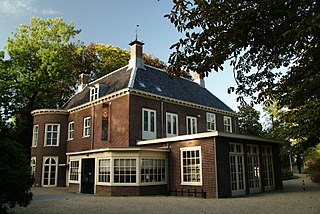
Gouda is a city and municipality in the west of the Netherlands, between Rotterdam and Utrecht, in the province of South Holland. Gouda has a population of 72,338 and is famous for its Gouda cheese, stroopwafels, many grachten, smoking pipes, and its 15th-century city hall. Its array of historic churches and other buildings makes it a very popular day trip destination.

Wijk bij Duurstede is a municipality and a city in the central Netherlands.

Woerden is a city and a municipality in central Netherlands. Due to its central location between Amsterdam, Rotterdam, The Hague, and Utrecht, and the fact that it has rail and road connections to those cities, it is a popular town for commuters who work in those cities.

Alphen aan den Rijn is a city and municipality in the western Netherlands, in the province of South Holland, between Leiden and Utrecht. The city is situated on the banks of the river Oude Rijn, where the river Gouwe branches off. The municipality had a population of 110,986 in 2019, and covers an area of 132.50 km2 (51.16 sq mi) of which 6.27 km2 (2.42 sq mi) is water.

The Oude Rijn is a branch of the Rhine delta in the Dutch provinces of Utrecht and South Holland, starting west of Utrecht, at Harmelen and runs by a mechanical pumping station into the North Sea at Katwijk. Its present-day length is 52 kilometres.

Werkhoven is a town in the Dutch province of Utrecht. It is a part of the municipality of Bunnik, and lies about 5 km east of Houten. Castle Beverweerd is located on the other side of the river.

Katwijk aan Zee is a seaside resort located on the North Sea at the mouth of the Oude Rijn. It is situated in the municipality of Katwijk and the province of South Holland.

Willem Roelofs was a Dutch painter, water-colourist, etcher, lithographer and draughtsman. Roelofs was one of the forerunners of the Dutch Revival art, after the Romantic Classicism of the beginning of the 19th century, which led to the formation of The Hague school. His landscapes, especially the early ones with their dominating cloudy skies, demure bodies of water and populated with cattle, are typical for the School of Barbizon.

Oog in Al is a residential area in the west of the city of Utrecht in the Netherlands. The Amsterdam–Rhine Canal, the Merwede Canal and the Leidse Rijn canal form the area's limits, rendering it a man-made island in the shape of a triangle.

Adriaen van Utrecht was a Flemish painter known mainly for his sumptuous banquet still lifes, game and fruit still lifes, fruit garlands, market and kitchen scenes and depictions of live poultry in farmyards. His paintings, especially the hunting and game pieces, show the influence of Frans Snyders. The two artists are considered the main inventors of the genre of the pronkstillevens, i.e. still lifes that emphasized abundance by depicting a diversity of objects, fruits, flowers and dead game, often together with living people and animals. Van Utrecht also painted a number of flower still lifes. He was a regular collaborator with leading Antwerp painters who had been pupils or assistants of Peter Paul Rubens, such as Jacob Jordaens, David Teniers the Younger, Erasmus Quellinus II, Gerard Seghers, Theodoor Rombouts, Abraham van Diepenbeeck and Thomas Willeboirts Bosschaert.
Calvary is the hill in Jerusalem where Jesus was crucified.

Crucifixion with the Virgin and St John by Hendrick ter Brugghen is an oil painting, now in the Metropolitan Museum of Art in New York City. It was probably painted c. 1625 as an altarpiece for a Catholic schuilkerk, a "hidden church" or "church in the attic", in the Calvinist Dutch United Provinces, probably Utrecht. When discovered in a bombed out church in South Hackney, London in 1956, it was unknown, but by the time it appeared in Sotheby's salesroom in November of that year it was recognized as an important example of Utrecht Caravaggism. It was acquired by the museum in the sale.

Gerard Hoet was a Dutch Golden Age painter and engraver.

Charles Cornelisz. de Hooch, was a Dutch Golden Age landscape painter and etcher.

Stichtse Vecht is a municipality of the Netherlands and lies in the northwestern part of the province of Utrecht.

Hendrik Heerschop, was a Dutch Golden Age painter.

Hendrik van Oort was a 19th-century painter from the Northern Netherlands. Among his best known works are In the Meadow and The Shoemaker, the latter of which is on display at the Northampton Museum and Art Gallery, painted some time between 1800 and 1830.
Van Rijn is a Dutch toponymic surname meaning "from (the) Rhine river". Common spelling variations are Van Rhijn and the anglicized version Van Ryn. People with this surname include:

Beverweerd Castle is a 13th century castle and former knight's court town, which is located on an island along the Kromme Rijn near the village of Werkhoven in the Dutch province of Utrecht. The castle is surrounded by landscaped gardens, in which the Kromme Rijn itself plays an important role in the landscape. The castle was empty for a long time and was not open to the public. Since 2006, painter and art forger Geert Jan Jansen has lived and worked at Beverweerd Castle. The surrounding gardens are ideal for walking, which offers a good view of the castle and the Kromme Rijn.

















